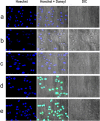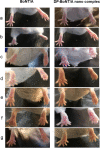Fabrication, characterization and evaluation of a new designed botulinum toxin-cell penetrating peptide nanoparticulate complex
- PMID: 37209247
- PMCID: PMC10238362
- DOI: 10.1007/s40199-023-00462-2
Fabrication, characterization and evaluation of a new designed botulinum toxin-cell penetrating peptide nanoparticulate complex
Abstract
Background: To have a better and longer effect, botulinum neurotoxin (BoNT) is injected several times in a treatment course, which could increase side effects and cost. Some of the most cutting-edge strategies being investigated for proteins to their physiologic targets involve the reformulation of BoNT based on peptide-based delivery systems. For this purpose, cell-penetrating peptides (CPPs) are of particular interest because of their capacity to cross the biological membranes.
Objectives: A short and simple CPP sequence was used as a carrier to create nanocomplex particles from BoNT/A, with the purpose of increasing toxin entrapment by target cells, reducing diffusion, and increasing the duration of the effect.
Method: CPP-BoNT/A nanocomplexes were formed by polyelectrolyte complex (PEC) method, considering the anionic structure of botulinum toxin and the cationic CPP sequence. The cellular toxicity, and absorption profile of the complex nanoparticles were evaluated, and the digit abduction score (DAS) was used to assess the local muscle weakening efficacy of BoNT/A and CPP-BoNT/A.
Results: The provided optimized polyelectrolyte complex nanoparticles had a 244 ± 20 nm particle size and 0.28 ± 0.04 PdI. In cellular toxicity, CPP-BoNT/A nanocomplexes as extended-release formulations of BoNT/A showed that nanocomplexes had a more toxic effect than BoNT/A. Furthermore, the comparison of weakening effectiveness on muscle was done among nanoparticles and free toxin on mice based on the digit abduction score (DAS) method, and nanocomplexes had a slower onset effect and a longer duration of action than toxin.
Conclusion: Using PEC method allowed us to form nanocomplex from proteins, and peptides without a covalent bond and harsh conditions. The muscle-weakening effect of toxin in CPP-BoNT/A nanocomplexes showed acceptable efficacy and extended-release pattern.
Keywords: Botulinum toxin; Cell-penetrating peptides; Dermatology; Digit abduction score; Drug delivery.
© 2023. The Author(s), under exclusive licence to Tehran University of Medical Sciences.
Conflict of interest statement
The authors declare no conflict of interests.
Figures








Similar articles
-
The rat Digit Abduction Score (DAS) assay: a physiological model for assessing botulinum neurotoxin-induced skeletal muscle paralysis.Toxicon. 2013 Sep;71:18-24. doi: 10.1016/j.toxicon.2013.05.004. Epub 2013 May 23. Toxicon. 2013. PMID: 23707612
-
Characterization of a membrane binding loop leads to engineering botulinum neurotoxin B with improved therapeutic efficacy.PLoS Biol. 2020 Mar 17;18(3):e3000618. doi: 10.1371/journal.pbio.3000618. eCollection 2020 Mar. PLoS Biol. 2020. PMID: 32182233 Free PMC article.
-
Uptake of botulinum neurotoxin into cultured neurons.Biochemistry. 2004 Jan 20;43(2):526-32. doi: 10.1021/bi0356698. Biochemistry. 2004. PMID: 14717608
-
The science and manufacturing behind botulinum neurotoxin type A-ABO in clinical use.Aesthet Surg J. 2009 Nov;29(6 Suppl):S34-42. doi: 10.1016/j.asj.2009.09.014. Aesthet Surg J. 2009. PMID: 19945003 Review.
-
Can Botulinum Toxin A Play A Role In Treatment Of Chronic Pelvic Pain Syndrome In Female Patients?-Clinical and Animal Evidence.Toxins (Basel). 2020 Feb 10;12(2):110. doi: 10.3390/toxins12020110. Toxins (Basel). 2020. PMID: 32050685 Free PMC article. Review.
References
MeSH terms
Substances
Grants and funding
LinkOut - more resources
Full Text Sources
Medical

